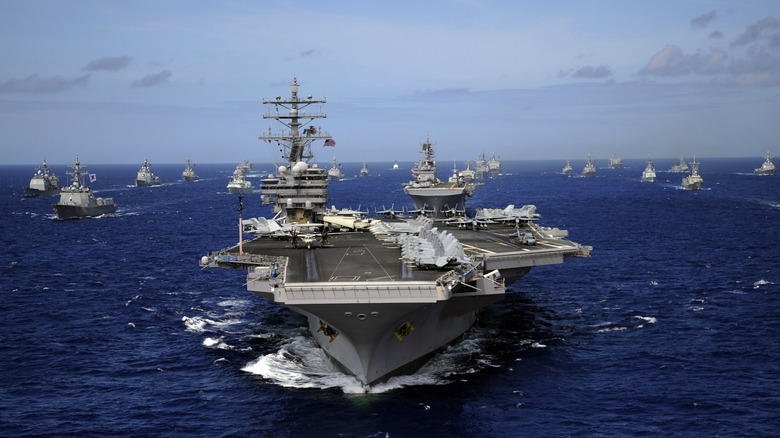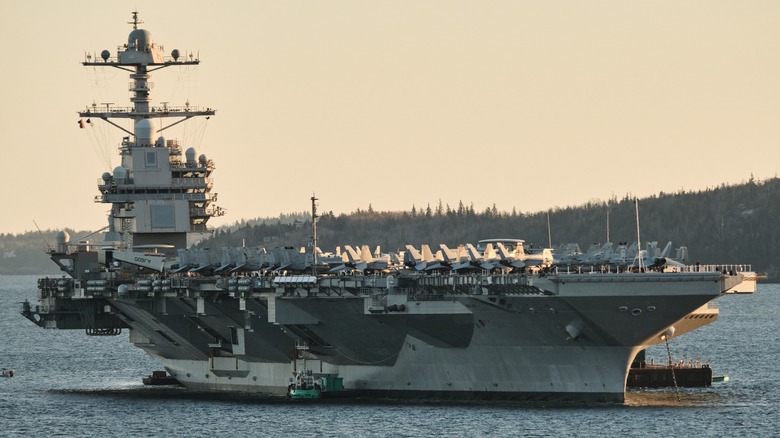
Stocktrek Images/Getty Images
Modern aircraft carriers are the most advanced and largest machines of war ever invented, with emphasis on «largest.» While aircraft carriers used in World War I and II were impressive and large vessels, they pale in comparison to what exists today. The U.S. fielded the Essex class of carriers during WWII, which displaced over 36,000 tons. That’s a lot, but the latest U.S. carrier class, the Gerald R. Ford, displaces 100,000 tons.
That’s a lot of weight to move about the ocean surface, but modern carriers are relatively swift despite their mass. Of course, the U.S. isn’t the only nation to use aircraft carriers, even if it has the most in operation, with 11 sailing as of mid-2024. China has five carriers in various stages of operation, while France has one. India, Egypt, the United Kingdom, Italy, South Korea, and Australia all operate two each, while Russia technically has one, but it’s not presently operational, with one allegedly under development.
Currently, the U.S. operates two classes of carriers, the Nimitz and Gerald R. Ford, and they both move through the water at comparable speeds. China’s carrier fleet consists of various ships, including the newly launched Fuijan. The U.K. operates two Queen Elizabeth-class carriers, while other nations use a variety of carriers either constructed in-house or purchased from other nations. Still, there are dozens of aircraft carriers around the world, but which country has the fastest?
The U.S. Navy’s fastest aircraft carriers

Wandering views/Shutterstock
As of mid-2024, the U.S. operates one Gerald R. Ford-class carrier and ten Nimitz-class carriers. As the Nimitz carriers are aged out of service, new Ford-class carriers will take their place. The USS Enterprise (CV-80) is currently under construction, and more will follow.
The Nimitz and the other carriers in its class are old; many of them are approaching their end of life after 50 years of service. The former USS Enterprise (CV-65), which was a Kitty Hawk-class carrier, was able to reach speeds of 33 knots (38 mph). The fastest Nimitz-class carrier is the USS George H.W. Bush (CVN-77), which could reach speeds of over 30 knots (35 mph). Nimitz vessels are slightly smaller than Ford-class carriers, weighing in at 97,000 tons of displacement.
While that’s only three tons fewer than a Ford-class carrier, it makes a difference, as the Ford can also reach speeds of over 30 knots (35 mph) via its powerful Bechtel A1B PWR nuclear reactors that deliver three times the power of a Nimitz-class carrier. Some of this power is directed to the speed of the craft, but other power is routed to its advanced systems. Still, both move at the same speeds as the ships in their Carrier Strike Groups, making them both the fastest.
Which country has the fastest aircraft carrier?
The top speed of American carriers is currently 30 knots, but what about other nations’ carriers? The U.K.’s Queen Elizabeth-class carriers weigh in at 65,000 tons and can move up to 25 knots (28.7 mph). China’s newest aircraft carrier, the Fujian (CV-18), is believed to be able to reach somewhere between 30 and 31 knots (35-35.6 mph) while displacing 80,000 tons. The estimate is likely based on China’s Shandong aircraft carrier, which displaces around 70,000 tons with a top speed of 31 knots.
Granted, these figures are estimates, as China and other nations aren’t in the habit of releasing the technical details of their military naval vessels. France’s fastest aircraft carrier is the Charles de Gaulle, which weighs 39,680 tons and can move at speeds of 27 knots (31 mph). India operates two Kiev-class aircraft carriers, weighing in at 45,000 tons with a top speed of 30 knots.
While dozens of aircraft carriers are in operation around the world today, many are small, outdated, and unable to exceed speeds of around 25 knots (28.7 mph). The more advanced carriers don’t go much faster, but they still manage to outpace their rivals. Of all the aircraft carriers in operation today, the fastest is China’s Shandong, which was commissioned in 2019. The Shandong can reach speeds of 31 knots (36 mph), which is helped by its size, as it weighs 70,000 tons with a full load.